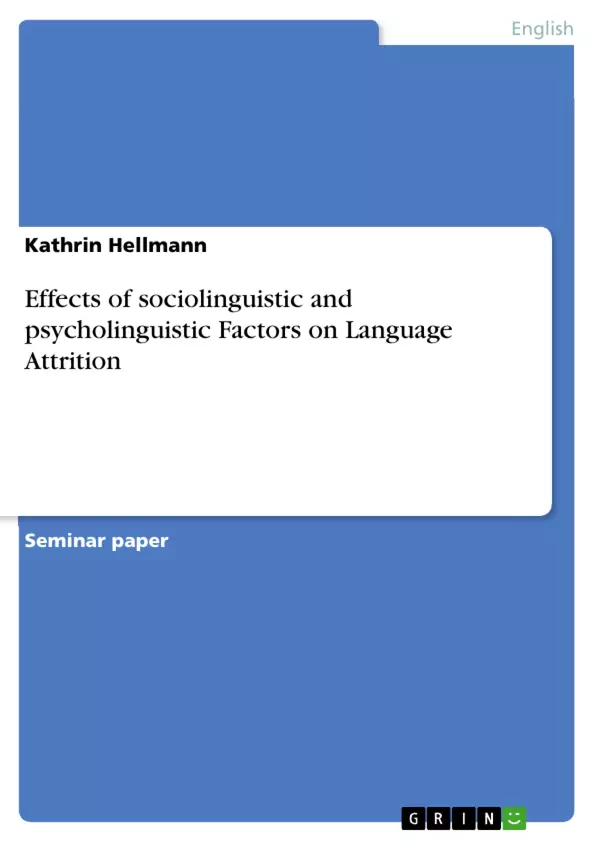Language attrition is a comparatively new research approach for socio- and psycholinguists all over the world. Their interests go into different directions, like the process of language attrition itself, the linguistic areas affected of forgetting or rather losing a language, and the “Effects of the Second Language on the First” (Cook 2003). But especially one topic divides the minds of the researchers: Which factors influence the loss of a language; and to what extent?
The elaboration at hand tries to answer this basic question with regard to the loss of the first language (from now on referred to as L1) in a foreign language (from now on referred to as L2) environment. Withal the focus lies on the attrition process in adults, although that of children is shortly introduced, too. The material put together and evaluated in this paper originates from several socio- and psycholinguists which conducted research on the different factors that have an influence on language attrition.
The first step to answer this question is to give a short overview on how two language systems can exist in one individual. As a part of this, it will be clarified what exactly is meant by the term “language attrition”, because it is often misunderstood. Afterwards, it will be easier to understand the connection between these two systems and therefore the reason why they are likely to be attrited. Furthermore, a closer look will be taken at the most common, non-pathological factors that have an impact on language attrition, parted into sociolinguistic and psycholinguistic factors. Their degree of influence on this process will be discussed thereafter with regard to the hypothesis: Sociolinguistic factors have a greater impact on the process of language attrition than psycholinguistic factors have.
Inhaltsverzeichnis (Table of Contents)
- Introduction
- Language attrition – two languages in one brain
- Factors influencing language attrition
- Psycholinguistic factors
- Sociolinguistic factors
- Discussion
- Conclusion
- Bibliography
Zielsetzung und Themenschwerpunkte (Objectives and Key Themes)
This thesis aims to explore the factors influencing language attrition, particularly the loss of the first language (L1) in a foreign language (L2) environment, focusing on adults. The analysis draws on research from socio- and psycholinguistics, evaluating different factors impacting attrition.
- The nature of language attrition and its process
- The relationship between two languages in one individual's mind
- The influence of psycholinguistic factors on language attrition
- The influence of sociolinguistic factors on language attrition
- The relative impact of psycholinguistic versus sociolinguistic factors on language attrition
Zusammenfassung der Kapitel (Chapter Summaries)
- Introduction: This chapter introduces the topic of language attrition, highlighting the research focus on the process, areas affected, and the impact of the second language on the first. It states the thesis's main question regarding factors influencing language loss and the scope of the analysis.
- Language attrition – two languages in one brain: This chapter discusses the different models of bilingualism, specifically Cook's integration continuum which describes the relationship between L1 and L2 in a speaker's mind. It explains the concept of attrition as a "difficulty in access to knowledge" rather than complete loss and clarifies that attrition can be slowed down or even reversed.
- Factors influencing language attrition: This chapter delves into the different factors impacting language attrition, divided into psycholinguistic and sociolinguistic factors. It outlines the role of age in L1 attrition, differentiating between adult and child attrition, and highlights the significance of the critical period.
Schlüsselwörter (Keywords)
Key terms and concepts explored in this thesis include language attrition, bilingualism, psycholinguistic factors, sociolinguistic factors, critical period, integration continuum, and the impact of L2 on L1.
- Quote paper
- Kathrin Hellmann (Author), 2014, Effects of sociolinguistic and psycholinguistic Factors on Language Attrition, Munich, GRIN Verlag, https://www.grin.com/document/342095



